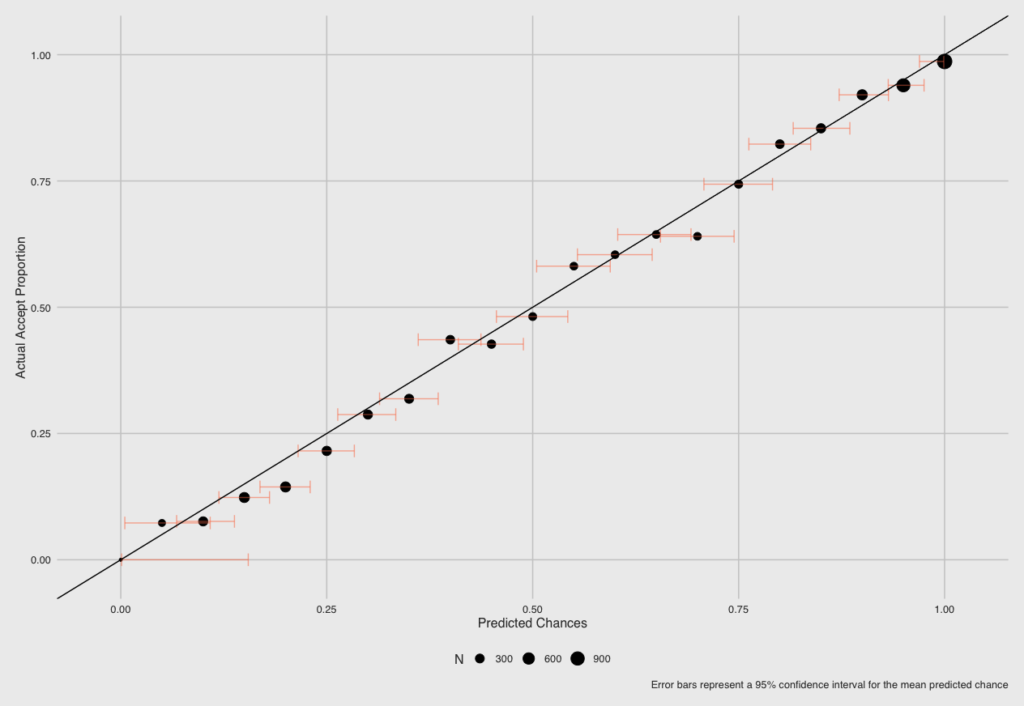Is CollegeVine’s Chancing Engine Actually Accurate?
What’s Covered:
- What is CollegeVine’s Chancing Engine?
- What Makes Our Chancing Engine Unique
- Factors that Are Considered in the Model
- Factors that Aren’t Considered
- Is CollegeVine’s Chancing Engine Accurate?
- How Our Chancing Engine Helps You
You may be wondering: how accurate is CollegeVine’s admissions calculator, and how can it help me refine my college strategy? CollegeVine’s chancing engine uses around 75 factors, including your grades, AP classes, extracurriculars, and more to predict your chances of admission at over 1500 colleges and universities. Keep reading to learn exactly what factors are and aren’t weighed in the chancing engine and learn how to best interpret the results you receive and find your dream school!
TL;DR: Is CollegeVine’s Chancing Engine Accurate?
This post provides context around how our chancing engine works and how to use it. If you’re simply interested in understanding how our predictions stack up to actual results, here’s a quick summary.
We’re happy to report that when we say students have an X% chance of getting in, very close to X% of that group actually gets accepted. See the below table for some specific data points and the plot of predicted chances vs. actual proportion of students accepted. For example, when we said students had a 50% chance of acceptance, 48.1% of those people actually got in.
|
CollegeVine Predicted Chance |
Actual Percentage Accepted |
|
5% |
7.2% |
|
15% |
12.3% |
|
30% |
28.7% |
|
50% |
48.1% |
|
80% |
82.2% |
|
95% |
94.0% |
Predicted Chances vs. Actual Proportion of Students Accepted

Continue reading to learn more about the context of our chancing engine. Or, if you want more discussion around the accuracy of our model, jump to this section.
What is CollegeVine’s Chancing Engine?
CollegeVine’s chancing engine helps you understand your chances of admission at colleges around the country. Using data about your personal profile and combining it with data about past acceptances at colleges around the U.S., the chancing engine gives you an estimate of your chances of being admitted to different colleges. To be clear, it’s an estimate of your chances, so even if you have an 85% chance of admission, it’s not a guarantee of acceptance.
Our model goes beyond traditional chancing engines like Naviance to give you a more personalized idea of your chances. Our model takes about 75 factors into account, not just your GPA and SAT scores. We will go over in detail which factors are and aren’t considered.
What Makes CollegeVine’s Chancing Engine Unique
1. Your results are personalized. By filling in your academic profile and extracurricular experience, we can give you the probability that you will be accepted to particular colleges and universities. For example, our chancing engine might tell you that you have a 20% chance of being accepted at a certain college when the average applicant has a 10% chance.
2. Our model uses real data. We compare you to thousands of applicant profiles by using the same process as real admissions officers. We routinely update our chancing engine to reflect the latest trends and most recent data in college admissions.
3. Our chancing engine gives you tips to improve your profile. Once you see your chances, we explain which parts of your application can be improved. This feedback is even specific to certain universities, as some may weigh course rigor, test scores, or extracurriculars more than others. This feedback will help you understand the weaknesses in your application and help you focus your efforts to strengthen your chances. We also have a chancing simulator that allows you to see how changing certain aspects of your profile (GPA, SAT/ACT, coursework, extracurriculars) will impact your chances.
4. You can learn to build a healthy school list. Since our chancing engine gives you a good idea of your competitiveness at specific schools, it will help you create a balanced school list of safeties, targets, and reaches.
What Factors Are Considered in the Chancing Engine?
The Biggest Factors
The big levers that move your chances the most are your GPA and standardized test scores. This is because many schools use the Academic Index to filter out applicants. The Academic Index is a single number that represents the strength of your GPA, test scores, and class rank (if your school ranks). Schools first want to make sure you’re academically qualified to attend, so if you don’t meet their standards, admissions officers may not even read the rest of your application. Because of this, your GPA and test scores matter the most for your acceptance and are weighted the heaviest in our model.
GPA: Your GPA is measured against the 25th percentile of past accepted applicants to determine your chances. We use the 25th percentile and not the average since your application is much more likely to be read if you clear this threshold.
Standardized Test Scores: Our chancing engine takes both SAT and ACT scores into account. As with your GPA, your score is compared to the 25th percentile of past accepted students to determine your chances.
Of course, due to COVID, many schools have test-optional policies, so you may apply without a score. Our chancing engine still works even if you don’t have scores, and we can also recommend whether you should apply with your current scores or not.
Course rigor: Advanced classes (e.g. AP or honors classes) are important to show colleges you are challenging yourself and that you’re prepared for the rigors of college. We compare your course rigor to that of successful applicants.
Extracurriculars: Admissions officers rank extracurricular activities using the tier system, with Tier 1 being the most exceptional and Tier 4 being the most common. Our chancing engine breaks down the tiers even further, with 12 sub-tiers total within the four tiers. Tier 1a encompasses the rarest achievements and Tier 4c represents the most common activities. Ranking your extracurriculars helps us more accurately predict your chances. For example, playing a JV sport will not be valued the same by an admissions committee as winning a national science research competition.
Ethnicity and race: Because the Supreme Court struck down affirmative action in June 2023, our chancing model does not account for ethnicity and race.
Other Factors
While the above factors are the most important levers in your chances, here are just a few of the other many factors our chancing engine considers.
Gender: Your gender will matter in select cases. The most obvious example may be applying to schools like MIT, where the acceptance rate for women is higher than for men (since there are many more male applicants, and the male applicant acceptance rate is lower). Our chancing engine factors this in.
Location: Your state residency is also a factor in the admissions process and considered in our chancing engine. For example, public schools value in-state applicants and often have tougher requirements for out-of-state students.
Intended Major: This is a factor that depends on the school and major. Some majors and career paths, such as STEM and pre-med, are more popular than others, so it’s often more competitive and harder to distinguish yourself from other applicants.
Are There Factors the Chancing Engine Doesn’t Consider?
While our chancing engine accounts for the most important factors, there are some things that we don’t yet consider, such as essays, rec letters, high school context, early decision, and legacy.
Keep in mind, however, that you can take this info that our chancing engine doesn’t have and adjust your interpretation of your chances. For example, if you know that your essays and rec letters are stellar and likely better than those of the average accepted student, your actual chances may be more favorable.
Essays
Your essays are your place to share your personality and voice. They certainly can have a big impact on your application, since admissions officers often use them to help choose between candidates with similar academic and extracurricular backgrounds.
Unlike academics, however, essays won’t decide whether your application is read, as we explained earlier with the Academic Index that selective colleges use to filter out applicants. Your GPA, test scores, and the acceptance rate of the school are most important in determining your chances. So, while we are currently working on adding essays to our chancing engine, our model can still give you a good idea of your competitiveness (assuming that your essays are on par with those of accepted students).
If you want feedback on your essays to make your application as competitive as possible, you can use Collegevine’s free peer essay review program. You can get feedback from other students and improve your own writing skills by editing others’ essays!
Recommendation Letters
Rec letters aren’t considered in the chancing engine because they play a very small role in admissions compared to grades and test scores, in most cases. They are also extremely difficult to account for. Students generally don’t have access to their rec letters, as teachers submit them directly, and most applicants sign waivers releasing their right to see the letters.
High school context
Admissions committees will look at your courses in the context of what is available at your school–something our chancing engine currently doesn’t do. So, if your school doesn’t offer any (or many) advanced courses, your chancing engine results may be slightly lower than your actual chances of admission.
Early Decision
If you apply early decision or early action, your chances are usually slightly higher. Applying ED will give you the largest boost, followed by a smaller benefit from EA apps. Our chancing engine does not yet take EA or ED into account, although we’re planning to add it for the high school class of 2023. For now, if you are applying ED/EA, your chances may be slightly higher than what CollegeVine predicts.
Legacy
Legacy is another factor not yet taken into account in the chancing engine, but we are working to add this factor into our model. Keep in mind, some schools value legacy more than others, but again, it is not one of the biggest levers in estimating your chances in the vast majority of cases.
As you can see, there are certain factors that could raise or lower your chances that our model isn’t accounting for. But remember, you can take these factors into account yourself and adjust your interpretation of your chances.
Is CollegeVine’s Chancing Engine Accurate?
Our chancing engine is a machine learning model. We measure the performance of the model with a metric called calibration, among several others. Basically, calibration is a metric that seeks to test how accurate the predicted chances are on aggregate. Our chancing engine is well-calibrated, meaning that, when we said people had a X percent chance, very close to X percentage of people in that group actually got in. You can see the plot below of our predicted chances and the actual acceptance proportion. Here are some examples from the plot:
|
CollegeVine Predicted Chance |
Actual Percentage Accepted |
|
30% |
28.7% |
|
50% |
48.1% |
|
80% |
82.2% |
|
95% |
94.0% |
Predicted Chances vs. Actual Proportion of Students Accepted

Keep in mind, however, that while the model is very well calibrated, our chancing engine is not definitive. We do not claim you will or will not get in. Rather, the engine is calculating your probability of acceptance.
For example, if CollegeVine says you have a 80% chance at 100 schools, you would get into around 80 schools if you applied to all of them (and rejected at around 20), given that your essays and rec letters are at least average. The thing is that you can’t (or at least shouldn’t) apply to 100 schools, so your actual results may seem more random. There may be schools where you have a high chance of acceptance, but you ultimately get rejected (and where you have low chances but ultimately get accepted).
Some may claim that our chancing is inaccurate as a result, but these unexpected outcomes just mean that you happened to be unlucky (or lucky), or that the other components of your application weren’t (or were) received well. The accuracy of a model can’t be measured based on individual data points; we must view the results in aggregate. When looking at all the students with an 80% chance at a specific school, it is true that some must be in the 20% that didn’t get in, but many are in the 80% that did get in.
This is why it’s so important to build a strong school list, as this will help counter the “randomness” of probabilities.
How CollegeVine’s Chancing Engine Helps You
CollegeVine’s chancing engine is meant to help you understand your chances at the schools on your list. After using our model, you won’t be going into the admissions process blindly.
The chancing engine is meant to help you in two concrete ways:
1. Manage your expectations.
CollegeVine will tell you how competitive your profile is. If you have over a 50% chance of admissions, you can be relatively optimistic. That being said, if you only have a 5% chance, it is way less likely you’ll be admitted, but don’t count yourself out. The admissions process is not black and white.
2. Help you create a balanced school list.
The chancing engine is very useful in helping you create a balanced list of safety, target, and reach schools. You want to make sure you’re applying to a healthy mix of schools so you have a good chance of getting into at least one. Since your chances are probabilities, the more schools you apply to, the more options you’re likely to have. Having a strong school list will put you in a comfortable and confident space going into the admissions process.
Our chancing engine can also help you find the ideal fit. Your chances of acceptance aren’t the only factor to consider when choosing a school. You’ll also want to consider other fit factors, including location, majors, size, financial aid, and many others. Using our school search tool, you can filter for colleges based on these factors, along with your chances.
Now that you know what to expect from CollegeVine’s chancing engine, give it a try! All you need to do is create a free account and you’ll find out your chances to over 1500 colleges and universities across the country.



